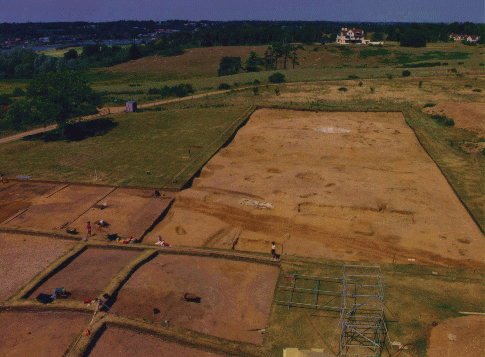
Picture of the Sutton Hoo archealogical site.
The Sutton Hoo
The Sutton Hoo burial ship was uncovered by archaeologists during the summers of 1938 and 1939. There was little more than the iron rivets left of the actual ship which was originally 89 feet long and 14 feet wide at its widest point. Marks left in the earth allowed archaeologists to determine the ship's dimensions. Jewelry, coins, silver plates, weapons, armour, utensils, drinking-horns, etc. were among the objects collected at the site.
It is believed that the ship was the grave of Raedwald, king of East Anglia until he died in 624 or 625. It is thought that the funeral ship was dragged approximately a third of a mile from the Deben river. It was then lowered into a trench and a wooden cabin was built. The body was decked in jewelry and other items were placed close at hand. Then the trench was filled and a mound was built over the ship. This idea of a burial mound is similar to what we saw at the end of Beowulf where we read:
In the barrow they placed rings and jewels, all such ornaments as troubled men had earlier taken from the hoard. They let the earth hold the wealth of earls, gold in the ground, where now it still dwells, as useless to men as it was before. Then the brave in battle rode round the mound, children of nobles, twelve in all, would bewail their sorrow and mourn their king, recite dirges and speak of the man. Norton, 67-68
To the Anglo-Saxons, burial goods were considered practical items that could be used by the dead in the next life and the ship would be the transportation to that life. The grandness of the items demonstrated the status of the individual. While this is considered a pagan form of burial, it is interesting to note that some of the items found at the site also had Christian associations.
(from The Anglo-Saxon Chronicles)